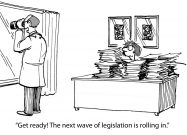School Choice's Window of Opportunity
In his essay “Opening Doors for School Choice,” Rick Hess has offered characteristically sage and sober advice to advocates of school choice. In the midst of the movement’s most successful year ever—five states have enacted universal education savings accounts or ESA-style policies so far, in addition to several more new or expanded choice policies—Hess urges advocates to leverage their momentum prudently.
The window of opportunity for school choice is still open, but who knows for how long? To take full advantage before the window closes, Hess advises advocates to focus on how school choice solves problems for parents; to pay attention to the details of how choice policies work for families and educators, from transportation to barriers to entry; to explain how choice policies better serve the public interest; and to ensure that choice policies serve all families, not just the worst off.
However, it is worth elaborating on a point Hess made in passing that holds the key to this recent progress. In explaining why parents embraced school-choice policies in the wake of the pandemic-era school closures, Hess observes:
Parents were left hungry for alternatives, especially amidst bitter disagreements over masking and woke ideology. This was all immensely practical. It wasn’t about moral imperatives or market abstractions. It was about empowering families to put their kids in schools that address their needs, reflect their values, and do their job.
The choice movement’s recent successes stem from a confluence of factors, but one key ingredient has been a shift in how some central players in the movement talk about school choice. In his seminal book Agendas, Alternatives, and Public Policies, John Kingdon argued there are fleeting moments in which a public policy problem, favorable political conditions, and a ripe policy idea are in alignment. School closures and the politicization of the classroom posed a significant public policy problem for many families to which school choice could provide a solution, both in offering parents an immediate escape hatch to educational alternatives and in giving parents more bargaining power with their local district schools. When school officials know that dissatisfied parents can take their money and leave, they have a strong incentive to listen. However, leveraging the favorable political conditions required choice advocates to connect with parents over cultural issues—an approach that the movement had previously avoided.
It should come as no surprise that the issue of values is what has super-charged the school-choice movement’s recent successes.
Since the initial and modest bipartisan successes in Milwaukee and Cleveland in the 1990s, the school-choice movement almost exclusively made its case in terms that appealed to liberals (equity, expanding opportunity for the most disadvantaged, etc.) or to libertarians (freedom, markets, competition, etc.)—what Hess describes as “moral imperatives” and “market abstractions.” However, the movement avoided making values-based arguments that appealed to conservatives out of a fear of alienating potential allies on the political left.
The excessive focus on winning political support from the left led the choice movement to embrace policies and rhetoric that undermined its own success. By proposing policies that limited eligibility only to students from low-income families and making the case for school choice about equity, choice advocates failed to appeal to, let alone win over, a majority of families. As Hess observes:
Before the pandemic, the case for school choice was typically made in personal terms only when it came to freeing low-income students trapped in failing schools. This kind of appeal gives the impression that choice is only a last resort for those trapped in poverty; that it’s not all that relevant for other families.
All the while, there’s been little appreciation for the limits of narrowly focusing on the worst-served urban families—even as a political strategy. After all, this approach tells the three-fourths of American parents who like their schools (and even disgruntled parents who live in rural areas and exurbs) that this isn’t about their kids or their communities.
For decades, the education-reform movement poured untold resources into cultivating Democratic politicians and leftwing groups with little to show for it. In solid-blue Massachusetts, a well-funded ballot initiative to raise the charter cap to help more disadvantaged kids in 2016 failed spectacularly. Sen. Cory Booker (D-NJ), once the darling of the school-choice movement, voted to uphold the Biden administration’s restrictions on charter schools.
All the recent legislative successes have been in red states, with bills generally passing along party lines or with only token support from a few Democrats. Meanwhile, little progress has been made in blue states—none of which have an ESA policy or anything close to universal school choice. Indeed, it is likely that the first state to lose a private school-choice program to legislative action (or, more accurately, inaction) will be Illinois, where the Democratic-controlled legislature is allowing a $100-million tax-credit scholarship program for students from low-income families to sunset.
Where choice advocates have been less comfortable, at least until recently, is in making the values-based case for school choice that recognizes these political realities. Parents want to pass on their values and culture to their children and they expect schools to aid—or at least avoid undermining—this process. Yet increasingly, parents are wary of schools that seem to be pushing an ideological agenda that is antithetical to their own values, such as teaching children that people are “oppressors” or “oppressed” based on their immutable racial characteristics or that “gender” is a “spectrum” that is unconnected to biological sex. Highlighting the gap between what parents want and what district schools are doing bolsters support for school choice because it is a solution to an immediate and deeply felt problem. As Jay Greene and James Paul recently documented, “engaging on cultural issues could produce a yield that is large enough to boost support for school choice into a clear majority position.”
It should come as no surprise then that the issue of values is what has super-charged the school-choice movement’s recent successes. When we conducted the largest-ever survey of participants in a school-choice program, the top two reasons Florida parents gave regarding why they chose their child’s school were “religious environment/instruction” (66%) and “morals/character/values instruction” (52%).
Parents know that education is about a lot more than test scores. As G. K. Chesterton put it, “Education is simply the soul of a society as it passes from one generation to another.”
To build majority support to enact choice policies in state legislatures, the low-hanging fruit has been rural Republicans, not urban Democrats.
For too long, the school-choice movement paid scant attention to the issues that mattered most to parents. That changed when public schools broke faith with families during the pandemic, remaining closed in response to teachers’ union demands long after officials knew it was safe to reopen. But in closing their doors, the schools opened a virtual window for parents to see what their children were learning. Many parents had concerns that the school content they were seeing was not aligned with their values, was age-inappropriate, or was not at the core of what schools should be doing. These parents did not become school-choice advocates overnight, and as Hess noted, “parents tend to like both their child’s public school and school choice policies.” It was only when parents came to appreciate how choice policies addressed their concerns—providing access to learning environments that aligned with their values and providing them greater leverage with their local district schools—that they embraced choice policies.
In addition to appealing to the issues about which parents care deeply, this approach can also win over conservative legislators who haven’t been sold on the idea of school choice. Again, as Greene and Paul documented in a separate study, of the 70 votes held to adopt a state school-choice program over the past few years, only three needed any Democratic support to get the bill over the finish line. Likewise, all the legislative wins this year—in Arkansas, Florida, Indiana, Iowa, Oklahoma, South Carolina, Tennessee, and Utah—were almost entirely driven by Republican lawmakers.
This is not to say that the school-choice movement should abandon appeals to liberals and Democrats or that it should put all its political eggs in the GOP basket. Lest we be misinterpreted, let us state clearly and emphatically that we believe that proponents of school choice should try to appeal to the broadest number of Americans and welcome advocates of all political stripes. The point is that such a coalition will also appeal to conservatives, in addition to liberals and libertarians, not that we believe the movement should exclusively appeal to conservatives. After all, the same policies that empower conservatives to choose traditional learning environments would allow liberals to choose progressive ones. In this way, school-choice policies turn down the heat of the culture war by allowing all families to choose schools that align with their values.
The opportunity cost of not appealing to conservatives has long limited opportunities for all families. To build majority support to enact choice policies in state legislatures, the low-hanging fruit has been rural Republicans, not urban Democrats. By avoiding the values-based arguments that would particularly appeal to conservatives, the choice movement unnecessarily prolonged success. It took three decades from the time the Milwaukee Parental Choice Program was implemented before more than a handful of states enacted robust school-choice policies.
Some have expressed concern that red-state victories make progress in blue states even less likely. But they weren’t making much progress anyway. In the long term, making the values-based case for education choice provides the best chance for actually passing enough choice policies to hit a tipping point that normalizes education choice nationwide.
Empowering families to choose the learning environments that align with their values is not only the right thing to do—it’s also the most politically viable strategy moving forward.

